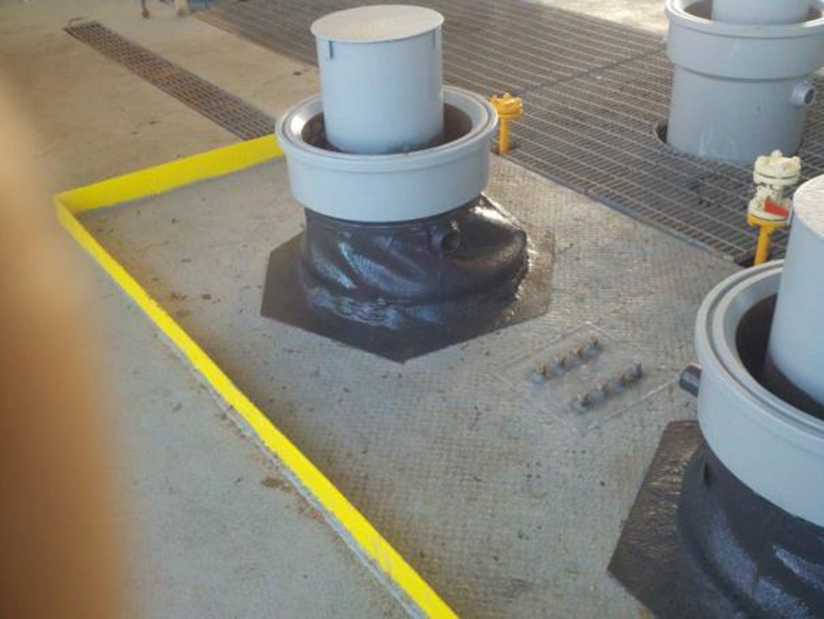The marine environment, both abrasive and corrosive, is unforgiving to maritime structures such as offshore platforms and rigs, and ocean-going vessels—all of which are major investments for the companies operating them. The structures in a marine environment are impacted by corrosion, which costs industry billions of dollars each year for its prevention, control, and remediation.
The environment of an offshore structure can be hard on surface coatings. Some of the areas most affected are the decks, superstructure, ballast tanks, and anchor or chain wells. These are exposed to salt and other chemical agents and are susceptible to abrasion caused by the movement of people and equipment. On an oil production rig, for example, the areas where the 14-m lengths of drill pipe are laid out, dragged across the deck, and then pulled up for drilling operations are prone to a large amount of damage. Most surface coatings are quickly abraded away, leaving bare metal that is vulnerable to corrosion.
One way to mitigate and minimize the effect of some types of corrosion is through the use of flexible surface coatings that are resistant to chemical attack from petroleum products and salts. According to Denis Baker, special projects engineer at Rhino Linings Australasia (Molendinar, Queensland, Australia), “A corrosion barrier has to have durability and flexibility in addition to being impermeable to the wide range of agents that affect maritime structures.” He notes it is possible to minimize some of the effects of drilling operations by applying specialized surface coatings. Rhino Linings has developed two pure polyurea coatings to protect maritime structures in the oil and gas industry from corrosion, impact, and abrasion.
To prepare working areas for treatment with a protective surface coating, the platform deck has to be abrasive blasted to remove any existing coatings and also provide a surface profile for optimum adhesion of the primer and protective coating. Zinc-rich primers can then be applied to the prepared metal surface, over which an elastomeric polyurethane sealant/primer is rapidly sprayed. Manufacturers have developed coatings that are good choices for this type of application because they have no volatile organic component (VOC) properties and can be easily and quickly applied. For maximum protection, a pure polyurea should then be spray-applied over the primed area to a nominal thickness of 3 mm on the deck surface. This final coating is resistant to extreme weather, and has excellent flexibility and high impact strength.
“Pure polyurea is a relatively modern material that has been developing rapidly during the past 15 years,” Baker says. Pure polyureas are formed when a liquid isocyanate is mixed under high pressure with an amine-driven resin solution. Isocyanates are reactive because the double covalent bond that attaches the carbon atom to nitrogen and oxygen atoms is easily broken to form single bonds in the more stable tetrahedral configuration around the carbon atom.
A major consideration in applying any surface treatment to a structure is the requirement to minimize downtime. Spray-coating enables quicker application and less disruption to a client's operations, and the ability to walk on a spray-applied protective surface in a matter of minutes means that a facility can be back online sooner. The beauty of pure polyurea coatings is that they are rapid setting, Baker says. They “snap cure” to form a solid surface in a few seconds and can be walked on without damage in less than a minute. “We can spray them on and they cure in as little as six seconds.” Unlike some other coatings, the pure polyurea coatings are not affected by ambient moisture or temperature while being applied, and their flexibility allows them to move with the expansion and contraction of the underlying structure as the temperature changes. Both are important considerations for an offshore coating. Another advantage is the coatings’ ability for it to be sprayed up to 6-mm thick (and greater) on a sloping or vertical surface without sagging or running. The resulting surface is easy to maintain, clean, and recoat if necessary.
Where pipes and other equipment penetrate the deck areas of an offshore structure, it is important that liquids do not run down the pipes to the ocean below. Most offshore rigs cover these penetrations with a butyl rubber “boot” that is taped to the pipe and the deck. However, the rubber of the boot and the adhesive can be degraded by UV and salt exposure in a matter of months.

To extend the operational life of the deck penetration boots, a protective coating can be applied. A pure polyurea is a suitable coating material to use with the boots. When applied at a thickness of 2 mm or greater to the boot and extended 50 mm on the pipe and 100 mm onto the deck, this type of surface coating creates a liquid-tight, weather-resistant, flexible interface on all deck penetrations from 100-mm in diameter with the long-term durability.
The butyl rubber and the adjacent steel surfaces are usually scuffed and cleaned, and an appropriate primer is applied. It is important that all loose coatings, oils, and dirt are thoroughly removed before applying a new flexible membrane. Similarly, the surrounding equipment, piping, and deck surfaces must be masked off to protect against over spray.
Pure polyureas for spray application are typically a two-part solution that is mixed under high pressure and temperature (~20.7 MPa psi at 65 °C) in a specially designed spray apparatus. When applied, the excellent chemical cross linking produces a dense but flexible surface. The high density makes the coating almost impervious to abrasion, water, and chemicals.